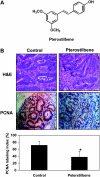Dietary intake of pterostilbene, a constituent of blueberries, inhibits the beta-catenin/p65 downstream signaling pathway and colon carcinogenesis in rats
- PMID: 20061362
- PMCID: PMC2899944
- DOI: 10.1093/carcin/bgq004
Dietary intake of pterostilbene, a constituent of blueberries, inhibits the beta-catenin/p65 downstream signaling pathway and colon carcinogenesis in rats
Abstract
Stilbenes are phytochemicals present in grapes, berries, peanuts and red wine. A widely studied stilbene, resveratrol (trans-3,5,4'-trihydroxystilbene), has been shown to exert antioxidant, anti-inflammatory, chemopreventive and antiaging effects in a number of biological systems. We reported earlier that pterostilbene (trans-3,5-dimethoxy-4'-hydroxystilbene), a structurally related stilbene found in blueberries, was effective in reducing the incidence and multiplicity of aberrant crypt foci formation in the colon of rats injected with azoxymethane (AOM). Our present study was to identify the chemopreventive potential of pterostilbene with colonic tumor formation as an end point and further to evaluate the mechanistic action of pterostilbene during colon carcinogenesis. F344 rats were given two AOM injections subcutaneously when they were 7 and 8 weeks old and continuously fed the control or 40 p.p.m. pterostilbene diet for 45 weeks. Overall analyses indicated that pterostilbene reduced colon tumor multiplicity of non-invasive adenocarcinomas, lowered proliferating cell nuclear antigen and downregulated the expression of beta-catenin and cyclin D1. Pterostilbene decreased mucosal levels of the proinflammatory cytokines, tumor necrosis factor-alpha, interleukin (IL)-1beta and IL-4. Colon tumors from pterostilbene-fed animals showed reduced expression of inflammatory markers as well as nuclear staining for phospho-p65, a key molecule in the nuclear factor-kappaB pathway. In HT-29 cells, pterostilbene reduced the protein levels of beta-catenin, cyclin D1 and c-MYC, altered the cellular localization of beta-catenin and inhibited the phosphorylation of p65. Our data with pterostilbene in suppressing colon tumorigenesis, cell proliferation as well as key inflammatory markers in vivo and in vitro suggest the potential use of pterostilbene for colon cancer prevention.
Figures





Similar articles
-
Pterostilbene, an active constituent of blueberries, suppresses aberrant crypt foci formation in the azoxymethane-induced colon carcinogenesis model in rats.Clin Cancer Res. 2007 Jan 1;13(1):350-5. doi: 10.1158/1078-0432.CCR-06-1528. Clin Cancer Res. 2007. PMID: 17200374
-
Pterostilbene inhibits colorectal aberrant crypt foci (ACF) and colon carcinogenesis via suppression of multiple signal transduction pathways in azoxymethane-treated mice.J Agric Food Chem. 2010 Aug 11;58(15):8833-41. doi: 10.1021/jf101571z. J Agric Food Chem. 2010. PMID: 20681671
-
Combination of atorvastatin with sulindac or naproxen profoundly inhibits colonic adenocarcinomas by suppressing the p65/β-catenin/cyclin D1 signaling pathway in rats.Cancer Prev Res (Phila). 2011 Nov;4(11):1895-902. doi: 10.1158/1940-6207.CAPR-11-0222. Epub 2011 Jul 15. Cancer Prev Res (Phila). 2011. PMID: 21764859 Free PMC article.
-
Gene mutations and altered gene expression in azoxymethane-induced colon carcinogenesis in rodents.Cancer Sci. 2004 Jun;95(6):475-80. doi: 10.1111/j.1349-7006.2004.tb03235.x. Cancer Sci. 2004. PMID: 15182426 Free PMC article. Review.
-
Biological actions and molecular effects of resveratrol, pterostilbene, and 3'-hydroxypterostilbene.J Food Drug Anal. 2017 Jan;25(1):134-147. doi: 10.1016/j.jfda.2016.07.004. Epub 2016 Sep 22. J Food Drug Anal. 2017. PMID: 28911531 Free PMC article. Review.
Cited by
-
Identification of abnormally expressed lncRNAs induced by PM2.5 in human bronchial epithelial cells.Biosci Rep. 2018 Sep 12;38(5):BSR20171577. doi: 10.1042/BSR20171577. Print 2018 Oct 31. Biosci Rep. 2018. PMID: 29899163 Free PMC article.
-
Java brucea and Chinese herbal medicine for the treatment of cholesterol granuloma in the suprasellar and sellar regions: A case report and literature review.Medicine (Baltimore). 2017 Feb;96(5):e5930. doi: 10.1097/MD.0000000000005930. Medicine (Baltimore). 2017. PMID: 28151875 Free PMC article.
-
Pterostilbene Targets Hallmarks of Aging in the Gene Expression Landscape in Blood of Healthy Rats.Mol Nutr Food Res. 2024 Dec;68(24):e2400662. doi: 10.1002/mnfr.202400662. Epub 2024 Nov 19. Mol Nutr Food Res. 2024. PMID: 39562169 Free PMC article.
-
Water extract of brewers' rice induces apoptosis in human colorectal cancer cells via activation of caspase-3 and caspase-8 and downregulates the Wnt/β-catenin downstream signaling pathway in brewers' rice-treated rats with azoxymethane-induced colon carcinogenesis.BMC Complement Altern Med. 2015 Jun 30;15:205. doi: 10.1186/s12906-015-0730-4. BMC Complement Altern Med. 2015. PMID: 26122204 Free PMC article.
-
Astragalus saponins downregulate vascular endothelial growth factor under cobalt chloride-stimulated hypoxia in colon cancer cells.BMC Complement Altern Med. 2012 Sep 19;12:160. doi: 10.1186/1472-6882-12-160. BMC Complement Altern Med. 2012. PMID: 22992293 Free PMC article.
References
-
- Jemal A, et al. Cancer statistics, 2009. CA Cancer J. Clin. 2009;59:225–249. - PubMed
-
- Center MM, et al. International trends in colorectal cancer incidence rates. Cancer Epidemiol. Biomarkers Prev. 2009;18:1688–1694. - PubMed
-
- Half E, et al. Colon cancer: preventive agents and the present status of chemoprevention. Expert Opin. Pharmacother. 2009;10:211–219. - PubMed
-
- Millen AE, et al. Fruit and vegetable intake and prevalence of colorectal adenoma in a cancer screening trial. Am. J. Clin. Nutr. 2007;86:1754–1764. - PubMed
-
- Rimando AM, et al. Biological/chemopreventive activity of stilbenes and their effect on colon cancer. Planta Med. 2008;74:1635–1643. - PubMed
Publication types
MeSH terms
Substances
Grants and funding
LinkOut - more resources
Full Text Sources
Other Literature Sources
Research Materials

